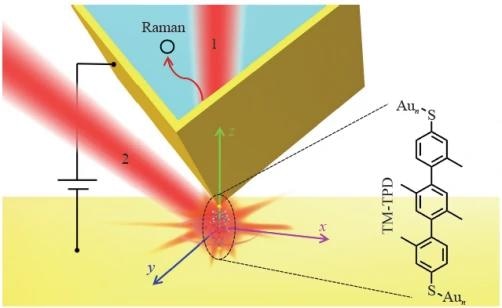Directing the behavior of a single molecule is crucial in advancing molecular logic operations and pushing the boundaries of nanoscale computing. In a recent breakthrough, a team from Jihua Laboratory in China unveiled a novel single-molecule Raman switch. This device is unique in that it responds to both applied electrical voltage and optical inputs varying in direction.
 The schematic configuration of optical and electrically driven single-molecular switch. It shows conformational switching in a tip−molecule−substrate junction with Raman readout via optical coupling of the optical angular momentum to the molecule. Laser illuminations from the top (channel 1) or the side (channel 2) are shown accordingly. Image Credit: Light: Advanced Manufacturing
The schematic configuration of optical and electrically driven single-molecular switch. It shows conformational switching in a tip−molecule−substrate junction with Raman readout via optical coupling of the optical angular momentum to the molecule. Laser illuminations from the top (channel 1) or the side (channel 2) are shown accordingly. Image Credit: Light: Advanced Manufacturing
The most common use of molecular junctions in nanoelectronics is electronic transport, yet their accurate characterization is a barrier to its widespread development. Most recent research has concentrated on exploring molecular junctions using electronic characterization. Light, in addition to applied voltage, can impact the molecular state and characterize molecular states. Light’s interaction with molecular junctions is an additional aspect of forming molecular switches.
Nevertheless, diffraction limits most standard optical spectroscopy techniques, making it challenging to characterize nanoscale systems with extremely high spatial resolution. Ultramicroscopy can benefit greatly from near-field-enhanced methods based on local surface plasmon (LSP), which can break the diffraction limit.
Highly precise methods for nano regions, such as coherent manipulation, processing, and measurement procedures for tunneling currents in nanoelectronic devices, are made possible by such near-field-enhanced approaches.
Scientists led by Dr. Hai Bi of Jihua Laboratory in China and colleagues have presented a single-molecular Raman switch that can be controlled by an applied voltage and optical inputs pointing in various directions in a new publication published in Light: Advanced Manufacturing.
The study examined the combined impact of the bias voltage and the near-field optical angular momentum on the Raman response of a single molecular junction, therefore forming a molecular switch. Optical and electrically induced conformational switching in the covalently connected metal–molecule–metal junctions of TM-TPD were characterized using a homemade molecular junction spectroscopy (MJS) platform.
The gold-coated tip of a tunneling microscope is electrically connected to a gold substrate via the non-π-conjugated molecular “wire” of TM-TPD. A previous finding that the molecular conjugation during charge transfer across molecular orbitals can be used to switch the molecule’s Raman activity on and off was verified by employing a TM-TPD molecular junction. This study further shows that an optical input could be used to control the molecular switch.
The switching behavior was controlled by examining the impacts of light polarization and the symmetry qualities that followed in the electromagnetic near field. A variation of the molecule’s structure is linked to this shift in the junction’s Raman response. With roughly five orders of magnitude difference between the two states, the Raman intensity can be switched ON and OFF by varying both the illumination side and the voltage applied to the junction.
It was demonstrated that the optical angular momentum in the near field, which is amplified by the plasmon gap mode in the junction, can regulate conformational molecular junctions in addition to the voltage given to a single-molecule junction. The Raman mode is triggered by a high bias voltage that causes the molecular junction's electron density to rearrange.
Planarization and higher π-conjugation of the TM-TPD molecule improve this Raman mode—a z-axis torque results from the angular momentum of light in an asymmetric electromagnetic field distribution.
This allows the TM-TPD to alter conformation, eliminates the transport electron density rearrangement, and eventually suppresses the Raman mode. These investigations demonstrated experimentally that optical angular momentum is a driving mechanism in molecular switching.
More specifically, it was discovered that angular momentum excitation is closely related to the symmetry of the near-field system. This finding offers new opportunities for molecular logic and optical angular momentum studies in the near-field region.
The study demonstrates how physicochemical phenomena can be studied at the single-molecule level, and it provides a platform for future generations of nanomechanical investigations employing MJS systems. Technologically speaking, these studies showed that single molecules can be monitored and controlled with remarkable precision, paving the way for multilogic single-molecule computing.
Journal Reference:
Zi, J. et al. (2023) Effect of near-field optical angular momentum on molecular junctions. Light: Advanced Manufacturing. doi:10.37188/lam.2023.034